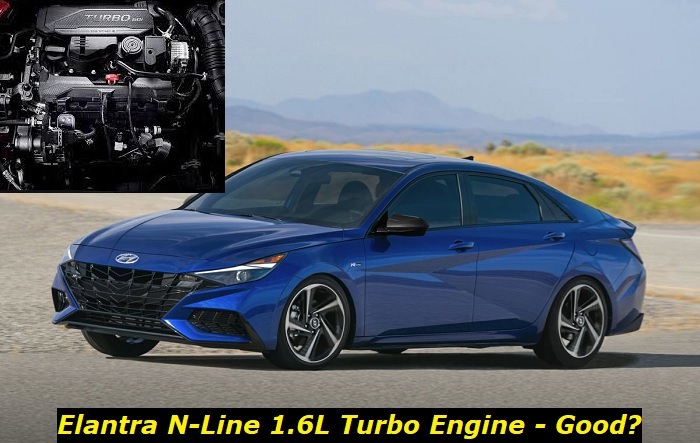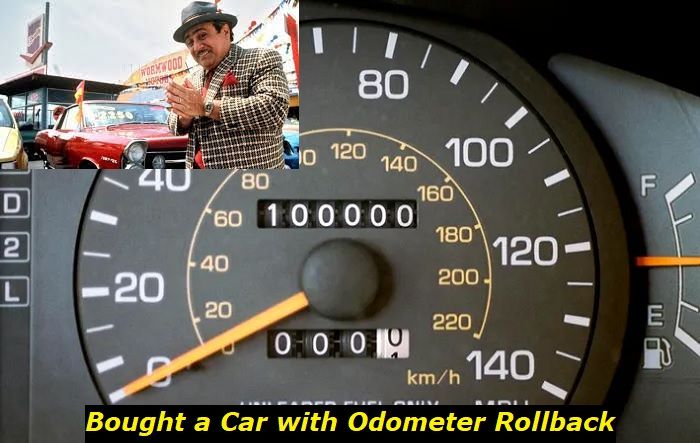The N-Line trim of the new Hyundai Elantra attracts a lot of motorheads who want the new car with an aggressive engine and cool tech. The Elantra is a relatively affordable compact sedan that offers a couple of cool trims including the version with a good turbo engine and some other important features that you can get for reasonable money.
Today, we'll tell you about the 1.6-liter turbocharged engine in the new Elantra N-Line and will also reveal its main advantages and drawbacks. You shouldn't think this is a sports version of the Elantra. If you want more from the vehicle, try the Hyundai Elantra N which comes equipped with the angriest engine you can find in this type of car. But today's article is not about the N.

Key facts and my opinion about the engine
- Production years: 2019-now
- Average lifespan of G4FP: 150,000-170,000 miles
- Fuel supply type: direct injection
- Power range: 180-204 hp
- Fuel efficiency: excellent
- Engine block material: aluminum
- Engine reliability score: medium
- The most common problems: potential CVVD system problems, potential turbocharger oil leaks, carbon buildup on intake valves, no lifters.
Key facts about the Hyundai Elantra 1.6L Turbo engine
So, the new Elantra comes with several available engines including the base slow 2-liter non-turbo option, the hybrid powerplant, the 2-liter turbo angry N engine, and also the 1.6L Turbo for the N-Line trim. A lot of engines to choose from - anyone can find an appropriate version. The 1.6L Turbo may not seem attractive at first to American buyers who love high-displacement engines. But let's not come up with premature conclusions.
The engine is the Smartstream G1.6T unit codenamed G4FP. The company also uses this engine in the new Sonata and in the KIA K5. Seems like a very solid engine with some new technologies that are hard to categorize in terms of longevity and this adds its pinch of salt. Overall, all advantages of the Smartstream family are here.
Some key facts about the engine:
- this is the 4-cylinder 1.6-liter G4FP engine equipped with a turbocharger, it has an aluminum head and block and features direct injection;
- the engine offers 201 horsepower and 195 lb-ft of torque and this is considered pretty great results for only 1.6 liters of displacement;
- the engine is equipped with the 7-speed dual-clutch transmission D7UF1 which has too few reviews to make any conclusions now;
- the timing system is driven by the chain which will make you spend some money approximately every 80,000 miles (chain replacement is recommended);
- the engine features a completely new system of valve timing called CVVD and this is one more key point for consideration - we don't know if it lasts;
- also, the company introduced a new turbocharger which should not have the same issues as previous Hyundai turbo engines;
- the engine is pretty economical and offers 28 MPG in the city and about 36 MPG on highways which is really good for such a car.
But you shouldn't expect to always see the claimed gas mileage on the screen of the trip computer. The problem is that the vehicle nearly asks you to drive aggressively and you will most often press that accelerator pedal hard. 201 hp of power is cool and you will feel this power in the middle range of RPMs, so rotating this engine is something natural you will want to do.
We don't like the idea of rotating engines too much because it gives you at least two problems: poor gas mileage and a limited lifespan. But the Elantra N-Line doesn't only offer cool power and torque, it also offers stiffer suspension for sportier feelings and the best handling. So, this is a sportier car than the base Elantra equipped with the 2-liter engine.
How many miles will the 1.6L Turbo Elantra engine go?
We don't know for sure because the engines have been made since 2019 and now the earliest models only hit 50-60 thousand miles and get out of the warranty mileage. No major problems are reported and it's good. But we are afraid in a year or two we will have much less optimistic statistics about the longevity of these engines.
First of all, they are small-displacement engines and they are revved up really hard to achieve optimal torque and power. This will cause some overheating and other issues. Also, these engines are the first Hyundai powerplants to utilize the CVVD technology. The system controls how long a valve is open and it's cool in terms of the engineering idea. But we are afraid it will cut the lifespan of the engine significantly.
Also, some other new-tech modules and the overall bad history records for the small turbocharged engines in Hyundai cars make us come up with a pessimistic prediction. We think the G4FP engine will only go 120,000 miles in your Elantra and then need some expensive repairs. But this also depends on your driving style, so you may change its lifespan by making good decisions.
What are the common problems with the 1.6L Turbo engine in the Elantra?
Lots of potential buyers are a little concerned about this engine after they test-drive the Elantra. And we understand their concerns. The engine revs up like hell, sounds like a Ferrari supercar powerplant, vibrates like crazy, and actually doesn't give as cool acceleration as you expect from it. But we wouldn't say this option is bad.
Here are some common problems you may encounter with this engine:
1. New tech problems
The CVVD system seems quite good but we don't know how it will work at 100,000 miles and after this milestone. We believe you will have some problems with it as well as with the work of valves, overall.
Also, the oil pump and thermostat are a little tricky and may need proper attention when the mileage approaches 100K miles. One bad thing is that they cost much and are pretty hard to replace. Also, if they secretly fail, you may overlook the symptoms and the engine will calmly die in several days.
2. No lifters - you will have extra expenses
As far as we understand, this engine still doesn't have hydraulic lifters. It means that the valves will need manual adjustment at least once every 30-40 thousand miles. But the interval will depend on your driving style and the quality of regular maintenance.
Overall, the engine is not cheap to maintain and keep in good condition. Although this is a pretty simple turbo powerplant, it will require more money than the average small engine on the American market.
3. Direct-injection problems
In newer engines, Hyundai started using combined injection featuring additional port injectors. But this one still has only direct injection and all the problems that come with it. The most important one is the carbon buildup that you will have to deal with now and then. Cleaning the valves is not the cheapest thing you will do with your engine.
4. Leaks and minor issues
We won't list all the minor issues that relate to this engine but there are dozens of them. You will face all these problems including oil leaks and coolant leaks for mysterious reasons after the engine hits the 50,000-mile mark. Also, closer to 100K miles, the engine will become really unreliable with a lot of minor issues happening quite often. At some point, repairing the engine becomes too expensive.
5. Timing chain issues
Just like all other modern Hyundai engines, this one has a pretty thin timing chain. The chain is going to stretch between 60,000 and 100,000 miles depending on your driving style and will need replacement. If you think that driving with a rattling engine is a good idea, you will probably have worse issues when this chain stretches a little more and jumps a tooth or two or just breaks. This will lead to engine replacement without the option of repair.
How can you prolong the life of your 1.6L Turbo engine in the Elantra?
You may have noticed that one of the most common phrases in our today's article has been "depending on your driving style". This engine may seem like a sporty machine but it isn't. It's just a small high-tech engine that was mistakenly inserted into a performance N-Line trim by Hyundai marketing specialists. And if you are buying it to abuse, better choose something else.
Here's what you should do to drive your Elantra N-Line G4FP engiine longer:
- avoid aggressive driving however ridiculous it may sound;
- regularly check the health of your turbocharger;
- check the timing chain after the car reaches 60,000 miles;
- avoid experimenting with the types of oil you are using;
- warm the engine up for 20-40 seconds before you start driving;
- check the clutch in the dual-clutch transmission at 80-100 thousand miles.
Better prevent all the major issues than solve those problems when they have already happened. This will save you money and time and prevent your frustration when the new Elantra hopelessly stops at the roadside.
About the authors
The CarAraC research team is composed of seasoned auto mechanics and automotive industry professionals, including individuals with advanced degrees and certifications in their field. Our team members boast prestigious credentials, reflecting their extensive knowledge and skills. These qualifications include: IMI: Institute of the Motor Industry, ASE-Certified Master Automobile Technicians; Coventry University, Graduate of MA in Automotive Journalism; Politecnico di Torino, Italy, MS Automotive Engineering; Ss. Cyril and Methodius University in Skopje, Mechanical University in Skopje; TOC Automotive College; DHA Suffa University, Department of Mechanical Engineering






Add comment